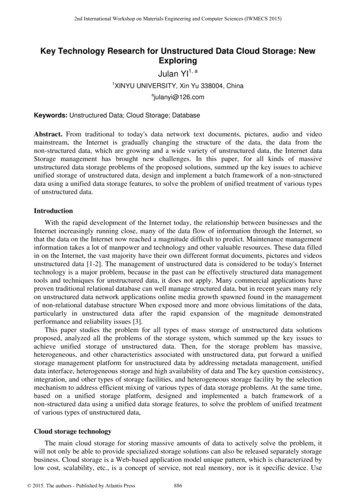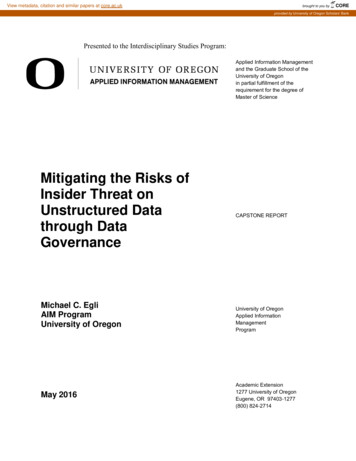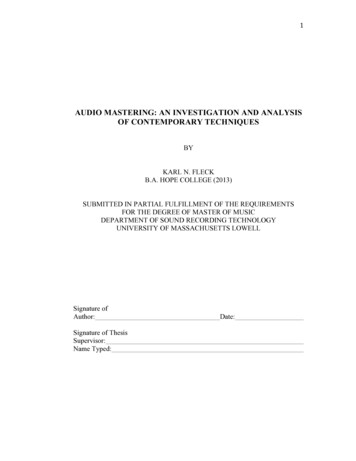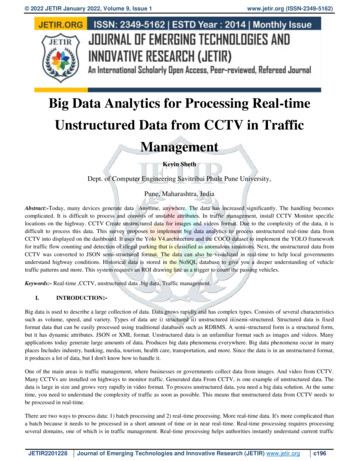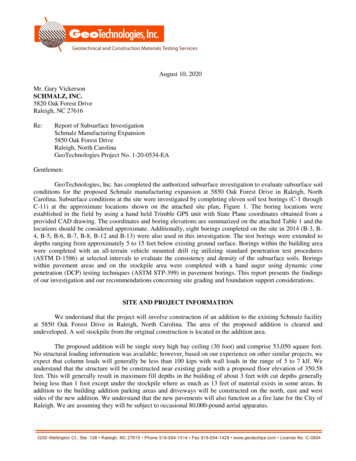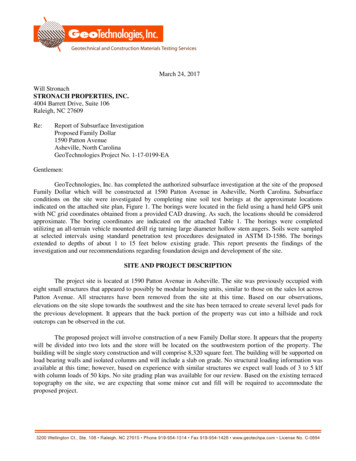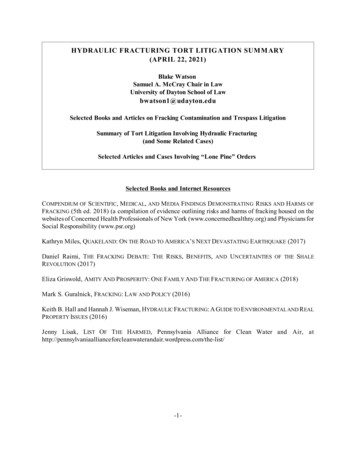
Transcription
IDC PERSPECTIVEMastering Unstructured Subsurface Data Management: bp'sKnowledge Mining ProjectGaurav VermaEXECUTIVE SNAPSHOTFIGURE 1Executive Snapshot: Mastering Unstructured Subsurface Data Management: bp'sKnowledge Mining ProjectSource: IDC, 2021March 2021, IDC #EUR146518120
SITUATION OVERVIEWThis IDC Energy Insights case study focuses on bp (a global oil supermajor). In 2018, it launched anambitious project to make all unstructured subsurface data accessible across its upstream operations.The project is part of bp's larger multiyear business information management program called"Document Neighbourhood Project."IDC interviewed Tracey Pearce, Senior Subsurface and Knowledge Management Specialist at bp, onthe major steps of the development and implementation of the knowledge mining solution that sits atthe core of the project. Building on a strategic partnership with Infosys, Microsoft, and Sword Venture,bp's subsurface data management project has been a great success. The company can now make alldata available to all relevant employees, irrespective of locations, for better decision making.IDC Energy Insights' Case Studies SeriesIDC Energy Insights' case study series provides oil and gas (O&G) companies with fact-based,consistent, and independent views on interesting projects implemented across the world. They focuson digital transformation (DX) initiatives, IT and operational technology (OT) solutionsimplementations, and more broadly, energy technology initiatives that contribute to efficiency,innovation, and sustainability. Collaborating with O&G companies and technology providers' personneldirectly involved in such projects, IDC Energy Insights analysts gather all relevant information andanalyze the approaches taken and the solutions' success in meeting stated goals.Company Overviewbp Plc is a multinational, vertically integrated British O&G company that employs around 70,000employees worldwide. bp traces its origins back to the Anglo-Persian Oil Company that discovered oilin Iran in 1908, and today it is one of the top 3 non-state-owned oil supermajors. Besides its leadershipposition across most of the O&G value chain — exploration and production (E&P), refining, and fuelretail — bp also invests in and supplies energy from low-carbon and renewable sources and is fullycommitted to growing its sustainable energy business. In fact, the company was the first oil supermajorto expand its activities beyond fossil fuels in the early 2000s, recently announcing its ambitious targetof becoming a net-zero emitter from its own operations by 2050.Unstructured Data in the Upstream BusinessA vast amount of structured and unstructured data is created daily in the E&P business. While all oilcompanies have developed processes and systems to manage the structured portion of this data,unstructured data is more difficult to handle and often remains scattered across multiple locations — inemployees' personal computers, emails, or as hard copies. They can contain information aboutanything: drilling reports, borehole logs, leasing agreements, third-party obligations, farm-in/farm-outdeals with peers, images of geological basins, historical survey charts, seismic interpretation oflithology, facies, etc. There is a vast amount of valuable and reusable information stored inunstructured data that it is not trivial to extract at scale.The ApproachBusiness Needs and Project Objectives: How the Idea of Knowledge Mining wasBorn at bpInformation about the subsurface is very costly to generate, and it remains highly relevant to theupstream business for a long time. For many upstream business decisions, bp's business leadersneed to refer to information gathered historically, sometimes dating back several decades. Thecompany operates in most major oilfields and works with thousands of contractors and vendors,generating massive amounts of data daily across its subsidiaries, site offices, and field operations allover the world. Around 80% of this data resides in unstructured form, spread across a multitude ofbusiness and operational systems. 2020 IDC#EUR1465181202
At the group level, bp has two datacenters providing data services to each of the Eastern and WesternHemispheres. All data from operations in the Eastern Hemisphere typically resides and is accessiblewithin the eastern data service and vice versa. As a result of this setup, employees often didn't haveany immediate means of accessing information residing in the opposite geographical data silo. Theyoften spent more time looking for the required information than working on it, most of the time withunsatisfactory results, as not all data was discoverable. For example, bp had multiple libraries indifferent disks in the eastern datacenter that most employees had no clue of. People operating in theEastern Hemisphere didn't know how many such libraries existed in the western datacenter, and noone really knew how many existed in total. This used to cause significant inefficiencies in some of bp'score upstream business processes. Besides, the company was losing information because whenpeople left the organization, knowledge often left with them.This is how the idea of bringing all file libraries in one place was born. The initiative was called theDocument Neighbourhood Project and was about "finding a home for the documents" so that usersknew where to keep unstructured data.With upstream being one of the most cost-intensive parts of the value chain, bp decided to make theprogram even more valuable for this business segment and made its information management teamwork on unstructured subsurface data as a specific extension to the Document NeighbourhoodProject. The objective was to maximize data value by intelligently consolidating dispersed data,eliminating all duplication, and extracting hidden information from historical data. While it may lookstraightforward on the surface, organizing unstructured data to make information intuitivelydiscoverable to all bp's upstream employees, regardless of their location, was far from easy.Selecting the Solution: The Foundation StoneSelecting the solution was one of the first challenges as there was no off-the-shelf solution that bp'sdocument control and information management team could have simply implemented. With thebusiness needs from operations, the group turned to Infosys –— one of bp's existing technologypartners. Infosys' deep understanding of bp's landscape, owing to a longstanding relationship with thecompany and its proven delivery capability with advanced cloud solutions, is what led bp to selectInfosys for this program.Infosys worked closely with bp's internal stakeholders to further refine the business requirements andset up a solution road map. Its developers and solution architects were challenged to propose the bestsolution for a massive unstructured data store of more than 75TB. The core need was to develop a toolthat could bring forth the wealth of subsurface domain information hidden into non-standard storageartifacts. For that, Infosys proposed using machine learning and natural language processingtechniques to efficiently tag upstream business entities.To develop an innovative, scalable, and accessible solution to store significant amounts of data ofdisparate nature, the project team soon realized a cloud platform was a first critical technicalrequirement. To that end, Infosys engaged Microsoft and brought in a knowledge mining solution builton Azure Cognitive Services and Cognitive Search.Solution DescriptionBased on Microsoft's knowledge mining framework, bp's solution architecture was built on an Ingest–Enrich–Explore model.Ingest: Breaking Down SilosThe first phase of the project was called "document discovery." It involved finding all documentscontaining unstructured data relating to the upstream business and moving them into Blob (object)storage containers on the Microsoft Azure cloud to what was called the "Document Store." It was a 2020 IDC#EUR1465181203
humongous task. "The biggest hurdle in this process was the migration of the enormous amount ofdata to the cloud. That alone, could have easily taken over six months," said Pearce.Infosys' developers and architects were challenged to find the right tool to accelerate the process, andafter evaluating several candidates, they eventually picked Microsoft's Fast Data Transfer as theoption that ensured the fastest possible migration.FIGURE 2bp's Knowledge Mining Solution ArchitectureSource: Infosys, 2021Enrich: Making Use of Every Byte of Domain Databp intended to create a domain-specific intelligent search platform that enabled its business leaders toeasily access all past business decisions and related key operational information. With this businessneed in mind, the team realized that they would have to extract the richest possible set of metadatafrom subsurface documents, which meant capturing every single domain entity (e.g., field, well, facies,lithology, geological period) and attribute that bp users would want to filter, sort, and group theinformation by.The documents and images that had been moved to the Document Store were enriched using AzureCognitive Search built-in functionality including document cracking (i.e., extraction or creation of textfrom non-text sources) and skills such as natural language and image processing (e.g., entity andoptical character recognition, language detection, key phrase extraction). Furthermore, custom skillswere developed and added to the pipeline to extract business domain entities and other relevantdocument properties (e.g., author, size, date of creation, and modification), and Azure Batch was usedto scale the actual computing. All extracted contents and metadata were transferred into a newstorage Blob called "Knowledge Store" for further analysis. 2020 IDC#EUR1465181204
In this phase, extracting domain-specific entities and metadata from some of the largest image filespresented a significant challenge that even the solution's built-in processing skills struggled with. Toaddress this, Infosys' developers created a series of enrichment algorithms that used a combination ofimage enhancement techniques to achieve higher accuracy.Explore: Enforcing a Culture of Data-Driven Decision MakingEnabling users to navigate through a wealth of domain data with maximum ease was a of the focus ofthe bp information management team. With documents enriched with domain entities and metadatanow available in the Knowledge Store, the next step was to build the smart search application to easilyexplore the subsurface information via keyword or geospatial search.The solution development team configured Azure Cognitive Search on the extracted metadata anddomain entities to index them. Infosys developers built a web search application for the indexedcontents to make them searchable. Finally, to enable map-based spatial search, the team integratedthe search application with bp's in-house geospatial platform — OneMap — leveraging dedicated GISconsulting services from Sword Venture.The user interface of bp's subsurface knowledge mining system was called Upstream SubsurfaceLibrary (USL). USL enables users retrieve all the basin and related geological, geophysical,operational data, field information, well-drilling information, and many more relevant entities within ageographic area by simply drawing a polygon on its map interface. They can then refine their searchby filtering out various business entities based on keywords.Solution DeploymentFrom Kick-Off to a Working Prototype in Six MonthsAs mentioned, the urgency of utilizing the wealth of unstructured data in bp's upstream decisionmaking process was the primary instigator of the project. It was April 2018 when the bp informationmanagement team took up the challenge to work closely with the line of business (LOB) to solve thecompany's chronic lack of unified information management, and the project was kicked off.Cross-functional collaboration and the inclusive work environment facilitated by bp enabled thesolution team to work in an agile fashion and rapidly develop a prototype. This was achieved by ateam of bp explorers, information managers, along with Infosys cloud architects to model a trulyscalable and intelligent cloud solution, the first of its kind on many aspects. By October 2018, the teamhad managed to: Migrate files to the storage Blob Extract domain entities Define metadata sets Develop the script for auto-extraction of metadata Georeference all files and extracted information Integrate into bp's OneMap geospatial platformThe final product underwent several improvements and refinements through a series of trials that tookplace during the following eight months. The business-critical nature of this data meant bp placedutmost emphasis on the cybersecurity aspect of the project. This held back the solution's final rolloutand even caused its approval to be put on hold for some time. After a thorough review process,additional security layers were applied to bp's data into the Blob storage and Cosmos database, whichenabled the solution to go into production in June 2019. 2020 IDC#EUR1465181205
Business ValueBoosting Productivity and Making Data-Driven Decisions a RealityThe deployment of the knowledge mining tool developed by bp's information management team hasbrought a paradigm shift in the way the company's employees access business-critical information,multiplying productivity and decision-making quality.With all subsurface business information only a few clicks away within a single cloud library, users canfinally spend more time analyzing data than looking for it.Business leaders, in turn, get quick access to exactly what they are looking for, helping them makebetter decisions faster. Exploring a new block, entering a joint venture for a new oilfield, and approvingor rejecting oil wells are examples of the type of business-critical and capital-intensive businessdecisions upstream business leaders are required to make. bp estimates that better-informed decisionmaking enabled by the knowledge mining tool will provide an estimated 50 million to 250 million invalue.Lessons LearnedThe Unconventional Approach That Put bp Ahead of the CurveSeveral factors contributed to the project's success. One of the most important was that theinformation management team owned the business project, rather than the IT department leading theprogram. This ensured not only LOB's commitment, but also that the right mix of business expertisewas available to the team. It also helped foster a shared vision between internal and externalstakeholders, including subsurface operations executives, the information management team, andtechnology partners, which was also a critical success factor.The use of DevOps and agile also contributed to the project's success. The information managementteam involved Infosys in bp's internal business meetings through regular touchpoints. A DevOps teamwas assembled, blending information management and document control personnel with solutionarchitects and developers. The active involvement of the LOB fostered a deeper understanding ofbusiness needs and desired outcomes on the part of developers and solution architects. The agilemethodology enabled the DevOps team to work closely, meet often and brainstorm, fail fast and learnfaster, and do things at scale. Ultimately, this helped speed up development considerably, with tasksthat could have easily taken up to six months executed in a matter of weeks. "DevOps doesn't onlymean an agile methodology, but also bringing dev and ops together in the fullest sense," said Pearce.Next Steps: Raising the BarNow that the standard is set, bp wants to raise the bar by making information management a trueenabler for the business. A lot is already in the pipeline: Ongoing refinement of the knowledge mining model. With bp re-inventing itself resulting innew business entities, there is an immediate need to re-align the model with the neworganizational structure. The solution needs to transform into an enterprisewide datadiscovery toolkit. With metadata auto-extraction and indexing capabilities in place, more setsof data can be ingested to further enrich the domain information that bp's business entitieshave access to. This will build a richer knowledge store of searchable data over time. Development of a knowledge graph. A potential future development of the currently deployedsolution is the creation of an enterprise knowledge graph. This would enable bp users to bepresented with search results in a more graphically rich form, helping them navigate throughcomplex interconnected information. Reaching beyond unstructured data. bp has a forward-looking data strategy whose goal is notonly to organize and integrate data, but also to extract the latent value in it (for instance, by 2020 IDC#EUR1465181206
extracting and reorganizing historical and current well-log data, as well as running analyticsusing AI and ML capabilities to obtain more accurate business insights). Improving structured databases. In the long run, another focus in which bp is actively investingis to make structured databases smarter through innovative technologies such as cloud,analytics, and automation.ADVICE FOR THE TECHNOLOGY BUYER Ensure data governance for the win. Many O&G organizations find data governance verychallenging, and not many have successfully created an effective governance model.Moreover, this is one of the factors that hold O&G companies back in their DX journey. Gooddata stewardship, a data quality framework, and best practices for data storage andmonitoring can greatly contribute to an organization's success. While creating and deployingdata governance may seem a daunting task, starting from a business' data pain points canhelp organizations acknowledge the need for better data rules and find the necessary focus. Reverse the 80-20 rule of data management. In most organizations, over 80% of time is spenton data discovery, preparation, and protection, while only 20% is spent on actual analytics andgetting to insights. Often, data management stops at the data discovery stage because peoplecan't find what they are looking for. Data intelligence and management solutions based onintelligent technologies have the potential to change this ratio by not only giving users theability to find data more easily, but also enabling them to understand the detailed context ofthe data. The maturity and availability of these technologies gives organizations an opportunityto quickly experiment with smaller data projects and eventually define a platform and a set ofbest practices that can be reused. Beware of extreme automation. Evaluate which data tasks, activities, and processes aresuitable to be automated by AI functionality. Ensure that you have considered all the risks andthat users understand their responsibilities and that of the machine. Even with automation,humans should be able to understand and explain outcomes. Most AI-based automationinvolved use mathematical algorithms for modeling and prediction, and its interpretation ofreality should be continually tested by humans.LEARN MORERelated Research Impact of IT-OT Integration on Oil and Gas Operations (IDC #EUR147433821, February 2021) Oil and Gas Industry Quarterly Update: October-December 2020 (IDC #EUR145815521,January 2021) IDC MarketScape: Worldwide Oil and Gas Asset Performance Management 2020-2021Vendor Assessment (IDC #EUR147032820, December 2020) IT-OT Integration Across the European Oil and Gas Industry: How We're Doing (IDC#EUR147006120, November 2020) IDC FutureScape: Worldwide Oil and Gas 2021 Predictions (IDC #US45818220, October2020) Oil and Gas Industry Quarterly Update: July-September 2020 (IDC #EUR145815420, October2020)SynopsisThis IDC Perspective analyzes how bp embarked on a subsurface knowledge mining project. bpintended to capitalize on the wealth of subsurface data it built over the years to boost the operationalefficiency of its upstream business. The report highlights the pressing business needs that triggered 2020 IDC#EUR1465181207
this initiative, the business value provided by the project, and bp's ambition to take this knowledgemining initiative to the next level in the future."A recent fad for upstream data search platforms is pushing oil companies to leverage innovativetechnologies such as AI, cloud, and Big Data analytics," said Gaurav Verma, research manager, IDCEnergy Insights. "While developing a search engine for structured data is relatively easy for largeorganizations, getting value from unstructured data is a very complex endeavor. bp's knowledgemining solution — co-developed with Infosys and Microsoft — is capable of extracting domain entitiesfrom historic unstructured upstream data, something that many other oil companies are stillexperimenting with." 2020 IDC#EUR1465181208
About IDCInternational Data Corporation (IDC) is the premier global provider of market intelligence, advisoryservices, and events for the information technology, telecommunications and consumer technologymarkets. IDC helps IT professionals, business executives, and the investment community make factbased decisions on technology purchases and business strategy. More than 1,100 IDC analystsprovide global, regional, and local expertise on technology and industry opportunities and trends inover 110 countries worldwide. For 50 years, IDC has provided strategic insights to help our clientsachieve their key business objectives. IDC is a subsidiary of IDG, the world's leading technologymedia, research, and events company.IDC ItalyViale Monza, 1420127 Milan, Italy 39.02.28457.1Twitter: omCopyright NoticeThis IDC research document was published as part of an IDC continuous intelligence service, providing writtenresearch, analyst interactions, telebriefings, and conferences. Visit www.idc.com to learn more about IDCsubscription and consulting services. To view a list of IDC offices worldwide, visit www.idc.com/offices. Pleasecontact the IDC Hotline at 800.343.4952, ext. 7988 (or 1.508.988.7988) or sales@idc.com for information onapplying the price of this document toward the purchase of an IDC service or for information on additional copiesor web rights.Copyright 2021 IDC. Reproduction is forbidden unless authorized. All rights reserved.
the major steps of the development and implementation of the knowledge mining solution that sits at the core of the project. Building on a strategic partnership with Infosys, Microsoft, and Sword Venture, bp's subsurface data management project has been a great success. The company can now make all
